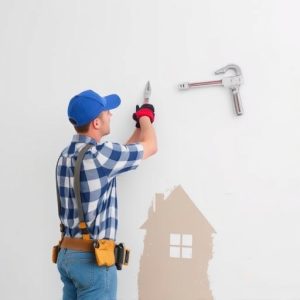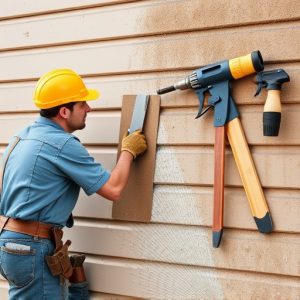Handyman Safety: Tips and Precautions for DIY Home Repair
When embarking on DIY home repairs, prioritize safety by wearing appropriate personal protective eq…….

When embarking on DIY home repairs, prioritize safety by wearing appropriate personal protective equipment (PPE), inspecting tools and materials, and reviewing project instructions and potential risks. A safety checklist is advisable to ensure ladders are stable, power tools are functioning, and essential safety gear like fire extinguishers and first aid kits are accessible. Essential handyman tips include understanding the specific tasks you're undertaking, recognizing the importance of electrical safety, ensuring chemical handling is done with proper ventilation, and knowing when professional help for gas-related issues is required. Proper tool handling is crucial; read manufacturer instructions, inspect tools for damage, select appropriate attachments, and wear protective eyewear, ear protection, and gloves to prevent accidents. Regular maintenance of power tools helps maintain safety standards. In case of an accident, prompt first aid and understanding the location of emergency equipment are vital, with immediate action recommended for serious situations like electrical shocks, fires, or severe injuries. Always keep a well-stocked first-aid kit handy and have important contacts at the ready. Document any incidents for insurance purposes and remember that attempting repairs beyond your skill level can pose significant risks. Adhering to these handyman tips will help ensure a safer repair experience, minimizing the likelihood of accidents and injuries.
Embarking on home repair projects can transform your living space and enhance its functionality. However, without proper precautions, these endeavors may lead to accidents. This article equips you with handyman tips for a safe DIY experience. We’ll explore essential safety gear for preparation, common hazards in home repairs, and the best practices for handling tools. Additionally, we’ll outline emergency protocols to follow should an incident occur. With these insights, you can confidently maintain safety while tackling repairs, ensuring your home remains a secure haven for you and your family.
- Preparing for Safe DIY Projects: Essential Safety Gear and Checklist
- Understanding Common Home Repair Hazards and How to Mitigate Them
- Toolhandling Techniques: Best Practices for Power Tools and Equipment
- Emergency Protocols: What to Do in Case of an Accident During Home Repairs
Preparing for Safe DIY Projects: Essential Safety Gear and Checklist

When embarking on DIY home repair projects, safety should always be a top priority to prevent accidents and injuries. A well-prepared handyman is one who can navigate tasks with confidence and care. To ensure your workspace is secure, begin by equipping yourself with the necessary personal protective equipment (PPE). This includes sturdy gloves to protect your hands from cuts, abrasions, and chemical exposure; safety glasses or goggles to shield your eyes from dust, debris, and flying particles; and hearing protection for loud environments such as using a chainsaw or sanding. Additionally, make sure you have the appropriate respirators or masks for tasks that may generate harmful fumes or dust.
Before starting any project, assess the task at hand and gather all tools and materials required. Read through the instructions thoroughly and identify potential hazards. A checklist can help: ensure ladders are stable and have non-slip feet; confirm power tools are in good working order and that you’ve read the safety manual for each; check that extension cords are in excellent condition without frayed wires; and verify that fire extinguishers and first aid kits are accessible. By adhering to these handyman tips for preparation, you can mitigate risks and approach your DIY projects with a safer and more informed mindset. Always remember to wear PPE specific to the task, such as a dust mask when sanding or insulated gloves for electrical work, and never attempt a repair that seems beyond your skill level or without proper supervision if necessary.
Understanding Common Home Repair Hazards and How to Mitigate Them

When engaging in home repair tasks, it’s crucial to recognize and address common hazards that can lead to accidents. Electrical work, for instance, poses significant risks if not handled with care. Always ensure you understand the circuitry layout before attempting any fixes. Use proper tools designed for electrical systems to prevent shorts or fires. Similarly, ladder safety is paramount when working on high areas. Ensure your ladders are stable and place them on firm, level ground. Never overreach or use chairs as a substitute for a proper step ladder. Wearing non-slip shoes can further enhance stability and prevent falls.
Another prevalent hazard is the improper handling of chemicals, particularly during painting or cleaning tasks. Always ventilate the area and follow safety instructions on product labels. Use protective gear such as gloves, masks, and goggles to shield against harmful substances. For those who are not professionally trained in gas-related work, it’s wise to hire a professional for any jobs involving gas lines or appliances. Unintended gas leaks can be catastrophic. Handyman tips often emphasize the importance of knowing your limits and when to seek expert advice. By understanding these common home repair hazards and implementing preventative measures, you can significantly reduce the risk of accidents and ensure a safer repair experience. Always approach each task with caution, respect for the work at hand, and a commitment to safety first.
Toolhandling Techniques: Best Practices for Power Tools and Equipment

When engaging with power tools and equipment, adhering to proper toolhandling techniques is paramount for preventing accidents and ensuring safety. Handymen, whether amateur or professional, should always start by reading the manufacturer’s instructions for each specific tool. These guidelines offer crucial insights into the operational parameters and limitations of the equipment. Proper preparation includes checking that all parts are intact, and the tool is functioning correctly before use. Selecting the right attachment or bit for the job can prevent damage to both the material you’re working on and the tool itself.
Safety gear is non-negotiable in the realm of power tools. Handymen should don protective eyewear, ear protection, and gloves to shield against debris, noise, and electrical hazards. Maintaining a firm grip on the tool with all five fingers, avoiding pinching positions, can prevent slips that might lead to injury. When cutting or sawing, ensure that your fingers, hands, and any bystanders are clear of the line of action. Use both hands to guide the tool, applying consistent pressure, and never force a tool if it resists movement, as this could lead to kickback or malfunction. Regular maintenance checks on tools, including sharpening blades and lubricating moving parts, will keep them in optimal condition, reducing the risk of accidents. By following these handyman tips for toolhandling with power tools and equipment, you can significantly lower the chances of an accident occurring in your home repair projects.
Emergency Protocols: What to Do in Case of an Accident During Home Repairs

When accidents occur during home repairs, immediate action is crucial to mitigate injury and damage. A well-prepared emergency protocol can save lives and prevent further complications. Homeowners or handymen should always have a first-aid kit readily available and understand how to use it. In the event of an electrical shock or fire, ensure that you know the location of your circuit breaker and fire extinguishers. For injuries resulting from falls or tool mishaps, applying immediate first aid is essential. If the injury is severe, contact emergency services without delay. It’s also wise to have the numbers of local hospitals and poison control centers prominently displayed. In cases where the accident involves gas leaks or structural instability, evacuate the area immediately and call for professional assistance. Remember to document the incident with photographs if safe to do so, as this can be helpful for insurance claims later on. Handyman tips often emphasize the importance of not attempting repairs beyond one’s skill level and ensuring that all equipment is in good working order before use. Adhering to these safety measures can significantly reduce the risk of accidents during home repair projects.
When engaging in home repairs, prioritizing safety is paramount to prevent accidents. This article has outlined critical safety tips for handymen and DIY enthusiasts alike, from preparing with the right gear and understanding common hazards to mastering toolhandling techniques and establishing emergency protocols. Adhering to these guidelines not only safeguards your well-being but also ensures that your home improvement projects are completed effectively. Remember, a job done safely is always a job well done. Always keep handyman tips in mind for a secure and successful repair experience.







